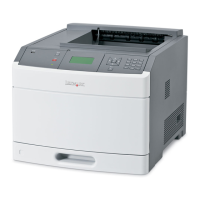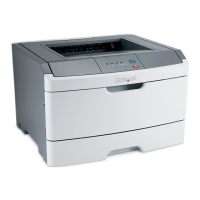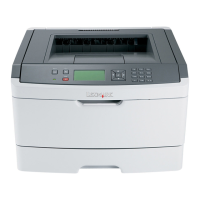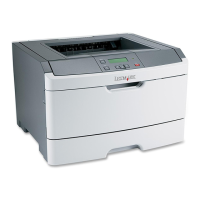Do you have a question about the Lexmark T430 and is the answer not in the manual?
Provides information about printer commands and languages supported by Lexmark printers T430, T640, T642, T644, and W840.
Offers guidance on navigating PDF files, including moving through the document and zooming.
Provides instructions on printing the document and notes on color accuracy.
Lists additional documentation for detailed information on printer commands and interfaces.
Explains methods to select PCL emulation using SmartSwitch, operator panel, or software.
Details using the Printer Job Language (PJL) Enter Language Command to select PCL emulation.
Illustrates printable and logical page areas for PCL emulation in portrait and landscape orientations.
Lists page sizes and print area dimensions for supported paper and envelopes.
Lists page sizes and print area dimensions for supported paper and envelopes.
Lists page sizes and print area dimensions for supported paper and envelopes.
Explains the Print Area menu item settings (Normal, Whole Page, Fit to Page) and their effects.
Details resident fonts and symbol set support for PCL emulation.
Explains forward and backward compatibility modes for emulating LaserJet fonts.
Provides tables to determine font/typeface support for symbol sets.
Details symbol set support for the Lexmark W840 typeface.
Introduces PCL emulation command structure, syntax, and parameter variables.
Lists PCL emulation commands grouped by function.
Details GL/2 commands, grouped by function, and printer support.
Explains commands for utilizing the raster area, including presentation, resolution, and compression.
Describes how to create and manage macros, including calling and executing them.
Defines character codes used for PJL command syntax illustration.
Explains the Universal Exit Language (UEL) command for printer language switching.
Details PJL JOB and EOJ commands for separating and managing print jobs.
Describes printer environment variables and PJL commands to modify or query them.
Modifies and stores default environment variable settings in printer NVRAM.
Modifies the current setting for an environment variable immediately.
Restores current and default environment variables to factory settings.
Resets current environment variables to NVRAM settings.
Lists common variables supported for both PCL and PostScript emulation.
Lists variables unique to Lexmark printers, supported in PCL and PostScript emulation.
Describes common variables used specifically for PCL emulation.
Lists variables unique to the printer and supported in PCL emulation only.
Describes common variables for PostScript emulation, common to Lexmark and HP printers.
Lists variables unique to printers and supported only in PostScript emulation.
Details variables for additional storage devices like flash and disk.
Allows requesting configuration and status information from the printer.
Lists status messages requiring operator intervention, independent of Auto Continue menu item.
Lists status messages requiring operator intervention.
Provides messages for operator intervention related to paper handling.
Lists PJL messages related to paper handling interventions.
Lists PJL messages indicating paper jams and required interventions.
Details error codes returned for service errors.
Lists commands for device attendance messages.
Specifies a message displayed on the operator panel when the printer is ONLINE.
Displays a message on the printer, taking it OFFLINE.
Displays a message on the printer, taking it OFFLINE.
Lists Lexmark unique PJL commands.
Commands to print internal information pages like directory, test page, fonts.
Modifies the code point of the escape character for the host computer.
Directs job output to the fax processing device instead of the printer.
Specifies the target device (RAM, flash, or disk) for downloaded files.
Commands to manage resources on flash and disk devices (open, close, read, write, etc.).
Provides information on password protection for files and devices.
Explains how to recover lost passwords using LQUERYSEED and LBYPASSPASSWORD.
Explains how to select PostScript emulation via SmartSwitch or operator panel.
Details using the ENTER LANGUAGE command for PostScript emulation.
Describes how the printer handles paper tray selection and actions.
Lists literal names supported as operators for changing image size for envelopes.
Explains how the printer selects envelope trays based on operator selections.
Provides a summary of PostScript operators and their functions.
Details page device parameters used by setpagedevice and currentpagedevice.
Describes user, system, and device parameters for the PostScript emulation interpreter.
Lists and defines system parameters used by the setsystemparams operator.
Details parameters for communication devices like Parallel, Serial, and USB.
Explains how printers return PostScript emulation error messages and status information.
Allows the printer to switch between PCL and PostScript emulation dynamically.
Customizes printer language selection for specific interfaces.
Details Printer Job Language (PJL) and the ENTER LANGUAGE command.
Explains how the printer examines data streams to automatically switch languages.
Saves information like fonts, macros, and symbol sets to flash memory or disk.
Steps to download resources using operator panel, MarkVision, or PJL commands.
Methods to view flash memory and disk contents: PJL command, operator panel, MarkVision.
Details two levels of password protection: Read/Write and Write.
Explains limitations and potential errors when rewriting flash memory content.
Explains file naming conventions and device names for PostScript emulation.
Describes how PostScript emulation operators search for devices.
Discusses potential performance degradation during initial resource access.
Explains storing incoming print jobs on the printer's disk.
Details how disabling job buffering affects the port and memory resources.
Describes how to handle jobs lost due to power outages and printer recovery.
Specifies room requirements to meet ASHRAE standards for airflow.
Lists noise emission measurements in accordance with ISO standards.
Provides electrical specifications for printer models.
Lists nominal average power requirements, including fuser power.
Details physical dimensions (height, width, depth, weight) for printer models.
Specifies minimum clearance needed around the printer for access.
Lists operating and shipping/storage temperature and humidity ranges.
Instructions for setting up communications ports in Windows operating systems.
Guidance on choosing between parallel, USB, and serial interfaces based on needs.
Details the parallel interface, including modes and signal descriptions.
Explains the printer's ability to send status messages to the computer.
Describes features enhancing data transfer reliability on the parallel interface.
Illustrates signal receivers and drivers for Lexmark T640x.
Explains serial interface operation, connection, and configuration.
Provides instructions on using the RS-232C serial interface.
Details connecting the printer to a network using internal or external print servers.
Explains the printer's input buffer sizes based on installed memory.
Lists PCL emulation commands and printer support, referencing command descriptions.
Lists GL/2 commands and identifies printer support.
Lists common PJL variables supported across printer languages.
Lists PJL variables unique to Lexmark printers supported in both PCL and PostScript.
Lists common variables specific to PCL emulation.
Lists variables unique to the printer and supported in PCL emulation only.
Lists common variables for PostScript emulation.
Lists variables unique to the printer and supported in PostScript emulation only.
Details variables for additional storage devices like flash memory.
Lists commands for requesting configuration and status information.
Lists unsolicited status variables that can be enabled or disabled.
Lists PJL messages for conditions requiring operator intervention.
Lists PJL messages for attendance conditions requiring operator intervention.
Lists PJL messages related to paper handling interventions.
Lists PJL messages indicating paper jams and required interventions.
Lists PostScript operators and their page numbers for reference.
Details page device parameters used by setpagedevice and currentpagedevice.
Describes user parameters used by setuserparams and currentuserparams.
Lists and defines system parameters used by setsystemparams.
Lists supported devices and their compatibility with printer models.
Details parameters for communication devices like Parallel, Serial, and USB.
Provides information about printer commands and languages supported by Lexmark printers T430, T640, T642, T644, and W840.
Offers guidance on navigating PDF files, including moving through the document and zooming.
Provides instructions on printing the document and notes on color accuracy.
Lists additional documentation for detailed information on printer commands and interfaces.
Explains methods to select PCL emulation using SmartSwitch, operator panel, or software.
Details using the Printer Job Language (PJL) Enter Language Command to select PCL emulation.
Illustrates printable and logical page areas for PCL emulation in portrait and landscape orientations.
Lists page sizes and print area dimensions for supported paper and envelopes.
Lists page sizes and print area dimensions for supported paper and envelopes.
Lists page sizes and print area dimensions for supported paper and envelopes.
Explains the Print Area menu item settings (Normal, Whole Page, Fit to Page) and their effects.
Details resident fonts and symbol set support for PCL emulation.
Explains forward and backward compatibility modes for emulating LaserJet fonts.
Provides tables to determine font/typeface support for symbol sets.
Details symbol set support for the Lexmark W840 typeface.
Introduces PCL emulation command structure, syntax, and parameter variables.
Lists PCL emulation commands grouped by function.
Details GL/2 commands, grouped by function, and printer support.
Explains commands for utilizing the raster area, including presentation, resolution, and compression.
Describes how to create and manage macros, including calling and executing them.
Defines character codes used for PJL command syntax illustration.
Explains the Universal Exit Language (UEL) command for printer language switching.
Details PJL JOB and EOJ commands for separating and managing print jobs.
Describes printer environment variables and PJL commands to modify or query them.
Modifies and stores default environment variable settings in printer NVRAM.
Modifies the current setting for an environment variable immediately.
Restores current and default environment variables to factory settings.
Resets current environment variables to NVRAM settings.
Lists common variables supported for both PCL and PostScript emulation.
Lists variables unique to Lexmark printers, supported in PCL and PostScript emulation.
Describes common variables used specifically for PCL emulation.
Lists variables unique to the printer and supported in PCL emulation only.
Describes common variables for PostScript emulation, common to Lexmark and HP printers.
Lists variables unique to printers and supported only in PostScript emulation.
Details variables for additional storage devices like flash and disk.
Allows requesting configuration and status information from the printer.
Lists status messages requiring operator intervention, independent of Auto Continue menu item.
Lists status messages requiring operator intervention.
Provides messages for operator intervention related to paper handling.
Lists PJL messages related to paper handling interventions.
Lists PJL messages indicating paper jams and required interventions.
Details error codes returned for service errors.
Lists commands for device attendance messages.
Specifies a message displayed on the operator panel when the printer is ONLINE.
Displays a message on the printer, taking it OFFLINE.
Displays a message on the printer, taking it OFFLINE.
Lists Lexmark unique PJL commands.
Commands to print internal information pages like directory, test page, fonts.
Modifies the code point of the escape character for the host computer.
Directs job output to the fax processing device instead of the printer.
Specifies the target device (RAM, flash, or disk) for downloaded files.
Commands to manage resources on flash and disk devices (open, close, read, write, etc.).
Provides information on password protection for files and devices.
Explains how to recover lost passwords using LQUERYSEED and LBYPASSPASSWORD.
Explains how to select PostScript emulation via SmartSwitch or operator panel.
Details using the ENTER LANGUAGE command for PostScript emulation.
Describes how the printer handles paper tray selection and actions.
Lists literal names supported as operators for changing image size for envelopes.
Explains how the printer selects envelope trays based on operator selections.
Provides a summary of PostScript operators and their functions.
Details page device parameters used by setpagedevice and currentpagedevice.
Describes user, system, and device parameters for the PostScript emulation interpreter.
Lists and defines system parameters used by the setsystemparams operator.
Details parameters for communication devices like Parallel, Serial, and USB.
Explains how printers return PostScript emulation error messages and status information.
Allows the printer to switch between PCL and PostScript emulation dynamically.
Customizes printer language selection for specific interfaces.
Details Printer Job Language (PJL) and the ENTER LANGUAGE command.
Explains how the printer examines data streams to automatically switch languages.
Saves information like fonts, macros, and symbol sets to flash memory or disk.
Steps to download resources using operator panel, MarkVision, or PJL commands.
Methods to view flash memory and disk contents: PJL command, operator panel, MarkVision.
Details two levels of password protection: Read/Write and Write.
Explains limitations and potential errors when rewriting flash memory content.
Explains file naming conventions and device names for PostScript emulation.
Describes how PostScript emulation operators search for devices.
Discusses potential performance degradation during initial resource access.
Explains storing incoming print jobs on the printer's disk.
Details how disabling job buffering affects the port and memory resources.
Describes how to handle jobs lost due to power outages and printer recovery.
Specifies room requirements to meet ASHRAE standards for airflow.
Lists noise emission measurements in accordance with ISO standards.
Provides electrical specifications for printer models.
Lists nominal average power requirements, including fuser power.
Details physical dimensions (height, width, depth, weight) for printer models.
Specifies minimum clearance needed around the printer for access.
Lists operating and shipping/storage temperature and humidity ranges.
Instructions for setting up communications ports in Windows operating systems.
Guidance on choosing between parallel, USB, and serial interfaces based on needs.
Details the parallel interface, including modes and signal descriptions.
Explains the printer's ability to send status messages to the computer.
Describes features enhancing data transfer reliability on the parallel interface.
Illustrates signal receivers and drivers for Lexmark T640x.
Explains serial interface operation, connection, and configuration.
Provides instructions on using the RS-232C serial interface.
Details connecting the printer to a network using internal or external print servers.
Explains the printer's input buffer sizes based on installed memory.
Lists PCL emulation commands and printer support, referencing command descriptions.
Lists GL/2 commands and identifies printer support.
Lists common PJL variables supported across printer languages.
Lists PJL variables unique to Lexmark printers supported in both PCL and PostScript.
Lists common variables specific to PCL emulation.
Lists variables unique to the printer and supported in PCL emulation only.
Lists common variables for PostScript emulation.
Lists variables unique to the printer and supported in PostScript emulation only.
Details variables for additional storage devices like flash memory.
Lists commands for requesting configuration and status information.
Lists unsolicited status variables that can be enabled or disabled.
Lists PJL messages for conditions requiring operator intervention.
Lists PJL messages for attendance conditions requiring operator intervention.
Lists PJL messages related to paper handling interventions.
Lists PJL messages indicating paper jams and required interventions.
Lists PostScript operators and their page numbers for reference.
Details page device parameters used by setpagedevice and currentpagedevice.
Describes user parameters used by setuserparams and currentuserparams.
Lists and defines system parameters used by setsystemparams.
Lists supported devices and their compatibility with printer models.
Details parameters for communication devices like Parallel, Serial, and USB.
| Color | No |
|---|---|
| Print technology | Laser printing |
| Type | Original |
| Printing colors | Black |
| Black toner page yield | 12000 pages |
| Harmonized System (HS) code | 84439990 |












